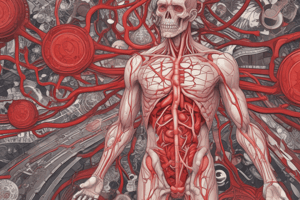Podcast
Questions and Answers
What is the significance of the left end of each bar in the diagram?
What is the significance of the left end of each bar in the diagram?
The ambient temperature at which the minimal resting metabolic heat production starts to increase.
What is the process called when an individual organism adjusts to a gradual change in its external environment, allowing it to maintain performance across a range of environmental conditions?
What is the process called when an individual organism adjusts to a gradual change in its external environment, allowing it to maintain performance across a range of environmental conditions?
Acclimatization
What is the upper lethal limit of a fish kept at 30°C?
What is the upper lethal limit of a fish kept at 30°C?
38°C
What is the difference in temperature tolerance between different species and the same species at different seasons?
What is the difference in temperature tolerance between different species and the same species at different seasons?
What is the term for the range of temperatures that an organism can tolerate?
What is the term for the range of temperatures that an organism can tolerate?
What is the mechanism of heat dissipation activated at the right end of each bar in the diagram?
What is the mechanism of heat dissipation activated at the right end of each bar in the diagram?
What is the process by which water becomes vapour, removing heat from the surface it is in contact with?
What is the process by which water becomes vapour, removing heat from the surface it is in contact with?
What is the term for the amount of heat required to change water from liquid to vapour?
What is the term for the amount of heat required to change water from liquid to vapour?
What part of the brain monitors temperature in terrestrial mammals?
What part of the brain monitors temperature in terrestrial mammals?
What is the consequence of the body failing to regulate its temperature effectively?
What is the consequence of the body failing to regulate its temperature effectively?
How do animals keep their bodies warm in cold temperatures?
How do animals keep their bodies warm in cold temperatures?
What type of receptors are sensitive to temperature on the skin of mammals?
What type of receptors are sensitive to temperature on the skin of mammals?
How does epinephrine increase heat in mammals?
How does epinephrine increase heat in mammals?
What is the difference between ectothermy and endothermy?
What is the difference between ectothermy and endothermy?
What is the primary way that animals lose heat from their bodies in hot environments?
What is the primary way that animals lose heat from their bodies in hot environments?
What is the purpose of vasoconstriction in thermoregulation?
What is the purpose of vasoconstriction in thermoregulation?
How do smaller animals, such as sheep and birds, cool their bodies in hot environments?
How do smaller animals, such as sheep and birds, cool their bodies in hot environments?
Why do smaller animals tend to be more efficient at cooling their bodies than larger animals?
Why do smaller animals tend to be more efficient at cooling their bodies than larger animals?





